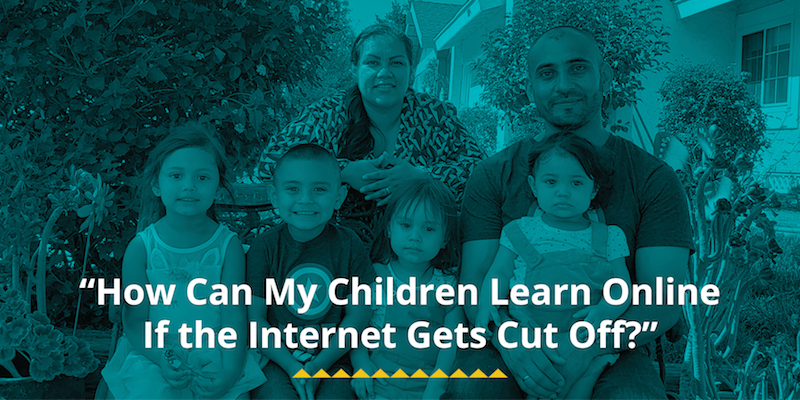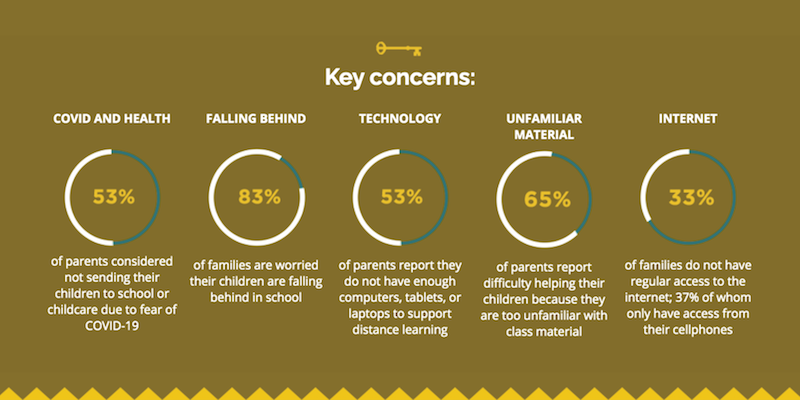
The challenges of distance learning during COVID-19
“To be honest in the beginning, it was nice,” says Joana Perez.
When the shelter-in-place order was announced in California in March, it was the first time in years that her husband, Jorge, was able to spend weekdays at home. “He's never taken a vacation, only for a few days after I was in labor. It was nice to have everyone at home together.”
As a mother of six children ages one to 15 years old, Perez was relieved to have help jugging the tasks of cooking, cleaning, helping the children with online school, and applying for emergency assistance loans.
In March, there were many resources: local nonprofit groups gave the Perez family help with bills, food, and rent. “But after month two, I started feeling the pressure. It was great to know Jorge wasn’t getting exposed [to coronavirus], but bills and rent needed to get paid,” she said. In April, Joana realized the emergency loans were one-time programs. “We started running out of avenues for support. I started feeling desperate.”
Online School When You’re Offline
Jorge had worked at Los Angeles Flower Market for 24 years selling wholesale flowers to party planners and florists. When all gatherings and events were canceled during the COIV-19 lockdown, his business sector dried up overnight. Without work, the family’s bills went unpaid.
“The internet got cut off in the second month,” Perez said. “My older ones did school through their phones, but the mobile hotspot was not big enough to do a Zoom meeting.” There was no way to connect with the Head Start and pre-K programs for her three youngest children, and she could see her oldest sons becoming frustrated and disconnected.
Christopher, 15, and Paul, 13, are both gifted students. Their A average started slipping to Cs. “Their teachers were less communicative with me, because Chris and Paul were doing fine—they were doing average,” said Perez. “But I know what they’re capable of. If they’re getting a C, they’re doing the bare minimum, and that’s unacceptable.”
The teachers didn’t have the time to connect with Perez personally about her children’s progress—and then Perez lost the wi-fi connection needed to participate in parent-teacher video calls.
Perez is among the 33 percent of Latino families across the nation without access to reliable internet. In the National Latino Parent Survey conducted by Latino Decisions and Abriendo Puertas, 37 percent of families reported they could only access the internet through their cellphones, making online learning tedious and inefficient.

By cutting back on groceries, Perez and her family were able to scrape enough money together to get the internet turned back on in May. Although she acknowledges the struggles with distance learning, she says, “I also don’t feel it’s smart to go back into the classrooms yet. The numbers speak for themselves.”
Studies have shown the rate of COVID-19 spread was dramatically decreased thanks to school closings last spring. Now, despite a second wave of rising coronavirus cases and business closures, there is increasing pressure from the White House for schools to fully reopen in fall of 2020.
“It doesn’t make sense for the kids or the staff. I wouldn't sleep well at night knowing we’re putting them at risk,” says Perez.
The Homeschool Blues
The cost-benefit analysis is difficult, she admits. She’s at a loss for how to help her children cope with the social isolation of lockdown. “My concern is that my kids’ mental health is at risk. They’ve been at home for so long.”
Chris, her 15-year-old, begs to meet his friends at the park. “But I worry if he comes back infected with something...there’s so many of us at home,” Perez says.
For now, park meetups are off limits. Instead, she tries to placate her teens by allowing lots of phone calls and regular online games with their friends.
She’s most concerned about the social development of her smallest children. “I’m worried because the little ones are missing out on the whole experience of sharing, problem solving, and interacting with other toddlers their age.”
Costs of the Classroom
However painful it is to watch her children struggle socially, Perez is too anxious about letting her children return to Los Angeles schools. “We’re one of the largest school districts in the country. We’re talking about 35 students in a classroom, it’s already overcrowded. How are they going to maintain six feet in a school with 700 students?”
For her part, Perez is asking her school district for more check-ins with teachers so she can better track her children’s academic progress. She stressed the need for more financial assistance for families, especially immigrant or mixed status families like her own, who struggle to pay their bills.
However high the costs of homeschooling, Perez says soberly, it’s worth it to her.
“I’m okay with my kids being at home until the end of the year. There will be catching up to do, sure, but kids can catch up. You can catch up in education, but you can’t bring them back from their deathbed.”
.
.


